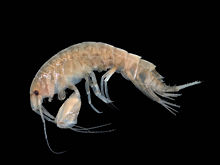Crustaceans are of considerable ecological and economic importance - read on to find out why!
Us humans consume a large number of crustaceans - especially lobsters, shrimps, prawns, crabs and crayfish. They form an important part of our diet, and are very nutritious.

Us humans consume a large number of crustaceans - especially lobsters, shrimps, prawns, crabs and crayfish. They form an important part of our diet, and are very nutritious.
The blue crab is held captive until it molts, then sold in a soft-shelled condition. After removal of the viscera, the whole animal is cooked and eaten.
Prawn fishery, which means capturing as well as culturing them, has advanced in many countries including Pakistan.
Crustaceans, the Food-Chain and the Ecosystem
Crustaceans, the Food-Chain and the Ecosystem
The smaller species of crustaceans form the bulk of the zooplankton, which plays a vital role in the food chains of both salt- and fresh-water fish, many of which eventually end up on our dinner tables.
Crustaceans as Fish Bait
Crustaceans as Fish Bait
In most parts of America, crayfish - especially the soft-shelled varieties - are very popular among fisherman as fishing bait.
Crustaceans as Scavengers
Crustaceans as Scavengers
Crustaceans are beneficial to the ecosystem as they play an important part in the destruction of decaying vegetables and animal bodies in the water.